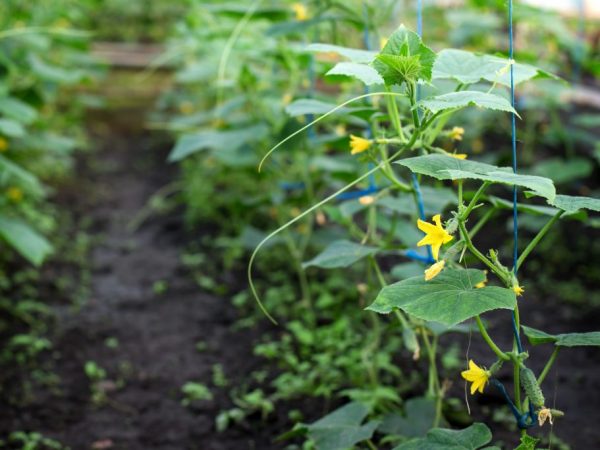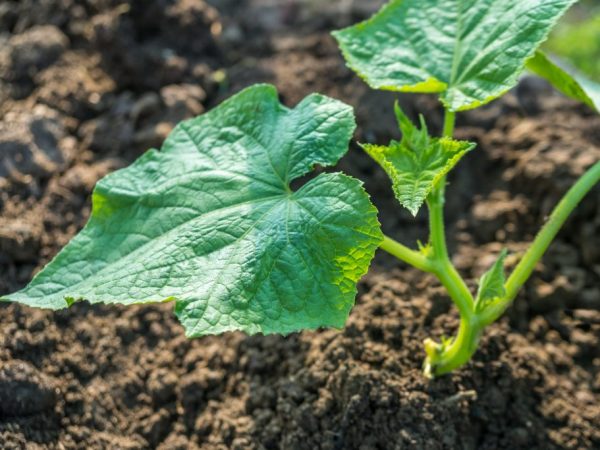Rules for growing cucumbers in the Leningrad region in the open field
Cultivation of cucumbers in the open field in the Leningrad Region will be successful if you take into account the peculiarities of the climate, choose the right varieties and adhere to the rules of agricultural technology. Hybrid varieties f1 have proven themselves well in this area.

Growing cucumbers in the Leningrad region
Climatic features
The Leningrad Region is characterized by short, cloudy summers, frequent rains and low temperatures. The region belongs to the zone of risky farming. The soil is predominantly acidic, podzolic, poor in organic matter.
The average temperature in the region in the spring-summer period ranges from 12 ̊C in May to 17 ̊C in July. In the south and north, these indicators differ by ± 2 - 3 ̊С.
Variety selection
The climate of the Leningrad Region is harsh for growing ordinary cucumbers in the open field and even in a greenhouse. Therefore, varieties of cucumber-hybrids for the Leningrad region need to be selected especially carefully. Such plants should be:
- undemanding to the quality of the soil;
- resistant to typical diseases of cucumbers;
- resistant to temperature extremes;
- self-pollinated;
- cold-resistant;
- early ripe.
Hybrid varieties are suitable for these characteristics - they are indicated by the F1 mark on the package. It is difficult to get such seeds on your own, you need to know how varieties are crossed and pollinated. Therefore, it is better to buy seed in a specialized store.
Cucumbers for cultivation in the Leningrad region are chosen early or super early ripening. This is due to the small number of sunny days.
Popular varieties
Among summer residents of the region, cucumbers of an early ripening and universal purpose are popular.
Cucumber seeds for growing in the Leningrad region:
- Petersburg Express F1 is an ultra-early hybrid, the first1 crop is harvested 38–40 days after germination. Well tolerates cold weather, undemanding to the soil, resistant to root rot and bacteriosis. Zelentsi are rich green, length 8-10 cm, seedless.
- Karelian is a high-yielding self-pollinated variety. The first greens are formed 45 days after germination. Fruits are short, thickened, light green, suitable for pickling or preservation.
- Altai early - ultra early variety. The first crop is harvested 37–39 days after sowing. Zelentsy weighing up to 80 g, 9-10 cm long, light green. Used for salads and preservation.
- Mayskiy F1 is an early maturing bee-pollinated variety. The first crop is harvested 46 - 48 days after germination. Zelentsy are elongated, 14 - 18 cm long, weighing 150 - 200 g. Resistant to root rot, powdery mildew.
- Suomi is an early ripe parthenocarpic cucumber. From germination of sprouts to the formation of the first harvest, only 38 - 40 days pass. Resistant to diseases and adverse weather conditions. The bush is vigorous, requires a garter.Zelentsy are tasty, without bitterness, 5 - 6 cm long. They are used for pickling, preservation, fresh consumption.

The choice of varieties is great
These varieties are recommended for cultivation in areas with unfavorable climates. Cucumbers for planting in the Leningrad region are resistant to sudden changes in temperature and summer frosts, they are undemanding to the soil. They are grown both in open ground and in a greenhouse.
Good disease resistance is another characteristic of these hybrids.
Growing cucumbers in the open field
To obtain the desired yield, you must first sow seeds for seedlings. Sowing dates are early to mid-May. The seeds have already been processed, and do not need to be pre-soaked - this only harms them. Cucumbers have delicate roots, so it is better to immediately plant them in peat cups so that when planting seedlings on a garden bed, they do not injure the plant.
The container with seeds should be placed in a warm place and covered with foil. As condensation forms, the film must be opened so that the sprouts do not start to deteriorate. After 5 - 8 days, the first shoots appear. Seedlings need to be fed once every 10 to 12 days with organic fertilizers. Young bushes at the age of 25-28 are planted in an open garden or greenhouse in mid-June, when the threat of frost has passed.
Transplanting
A place for future cucumbers is prepared in the fall. Complex mineral or organic fertilizers are applied to the beds. In the spring you need to dig up the ground, you can add wood ash. If no fertilizers were applied to the site in the fall, then in the spring you need to apply mineral fertilizer.
How to fertilize cucumber soil
For 1 m², make:
- 2 tbsp. ash;
- 1 tbsp. l. urea;
- 1 tbsp. l. potassium sulfate;
- 2 - 3 tbsp. l. superphosphate.
How to prepare a site
Dig up the site well, break large clods. Additionally, you can spill the beds with any organic fertilizer. This can be either a commercially available ready-made solution, or diluted mullein or chicken droppings.
How to drop off

Protect plants from frost
Seedlings are planted at a distance of 40-50 cm between bushes and about 1 m between rows. To protect the seedlings from freezing, it is imperative to build a covering structure. To do this, I use arcs that are convenient to cover with captivity. In July, when the temperature reaches its peak, the film is removed, and the lashes of the bushes are directed to the trellises.
How to feed during the growing season
During the growing season, the bushes are fed with organic fertilizers (mullein infusion, bird droppings, nettle infusion). In the conditions of the region, bushes are sprayed on vegetative parts for speedy growth, since at low temperatures the roots do not absorb nutrients well.
Cucumber care
Caring for cucumbers in the region requires compliance with some rules. These include:
- Loosening the soil.
- Regular watering.
- Weed cleaning.
- Garter.
Loosening
Loosening the soil allows the roots to breathe and get more nutrients from the ground and from top dressing. - The procedure is carried out 1 time in 2 - 3 weeks.
Watering
Watering is carried out at the root only in the evening with settled water. The land near the bushes can be mulched with hay. Such a measure to retain moisture, prevents the growth of weeds and, in the event of night frosts, will protect the roots.
Weeds
If we do not carry out timely weeding of the beds, the weeds will drown the plant, taking away the nutrients intended for it and blocking out the sunlight.
Garter
If the bushes are vigorous, then they need to be tied up on a trellis. Shrub forms do not allow strong lateral shoots and grow compactly.
Disease Prevention and Pest Control
Cucumber varieties for the Leningrad region are resistant to typical diseases. Prevention comes down to watering rationing and regular feeding.
Pay special attention to the fight against aphids and spider mites. The first signs of their appearance are twisted yellowed leaves.White bloom and beetles appear on the back of the sheets.
For prophylaxis, phosphorus-potassium preparations are used. Mix 10 gr. potassium chloride with 20 gr. superphosphate and 10 liters of water. The resulting solution is sprayed with bushes once a month.
If preventive measures do not help, then they carry out processing with biological products "Aktofit" or "Fitoverm".
Conclusion
An unfavorable climate for growing cucumbers is not a reason to refuse home-grown vegetables. You can grow cucumbers in the Leningrad Region in a greenhouse and in the open field. To do this, choose ultra-early hybrids that tolerate cold and frost well.

